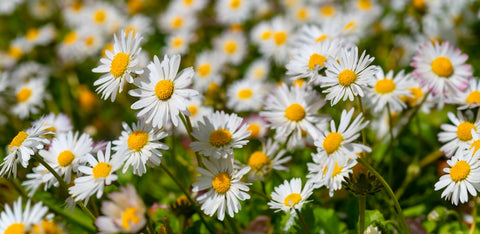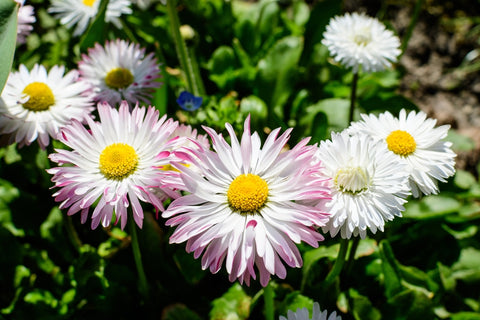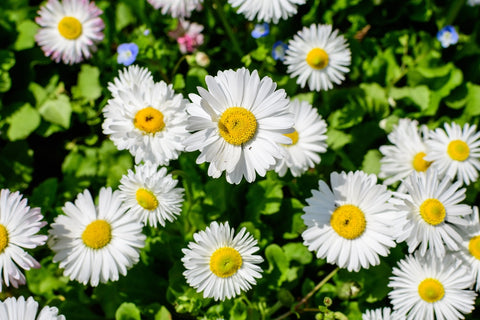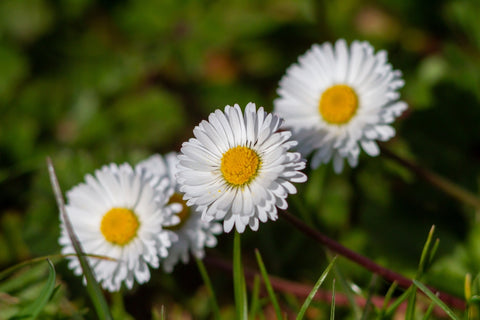A genus name for the Daisy flower, Bellis flowers are European species of the family Asteraceae. In order to distinguish it from other flowers called daisies, the Bellis perennis is often called the "Common Daisy flower", "Lawn Daisy" or "English Daisy".
• Does The Daisy Flower Come With Its Benefits?

There's a lot of ornamental value that comes attached with Daisy flowers but have you ever wondered if it has any other benefits? Well, yes, the Bellis perennis come with their own set of benefits that might just convince you to grow these lovely, delicate blooms in your own garden!
Here are a few of the benefits
1. Pollinators Love Bellis Flowers
English Daisies are excellent attractors of pollinators such as bees, butterflies, and hoverflies. These insects play a crucial role in pollinating other plants in the garden, promoting biodiversity and ensuring the reproduction of flowering plants.
2. English Daisies are the Perfect Garden Ornaments
With their charming appearance and prolific blooming habit, English Daisies serve as delightful garden ornaments. They add a pop of color and texture to flower beds, borders, and containers, enhancing the overall aesthetic appeal of outdoor spaces.
3. Daisy Flowers Naturalize Landscapes

English Daisies have a tendency to naturalize in suitable environments, spreading gradually and filling in gaps in landscapes. This naturalizing tendency can create beautiful, low-maintenance displays of daisies in meadows, lawns, and woodland areas.
4. They Also Improve Soil Structure
As perennial plants, English Daisies help improve soil health over time. Their extensive root systems work to aerate the soil, enhance water retention, and prevent erosion. As the plants die back in winter, their decomposing foliage adds organic matter to the soil, enriching it for future plant growth.
5. Bellis Flowers Have Therapeutic Uses
Beyond their aesthetic appeal, English Daisies have been used for their therapeutic properties in traditional herbal medicine. Infusions or extracts made from daisy flowers have been utilized for their anti-inflammatory, astringent, and wound-healing properties. They have also been used in herbal teas or topical preparations for soothing skin irritations and promoting relaxation.
6. Additionally, They're Low Maintenance

English Daisies are relatively low-maintenance plants, making them suitable for beginner gardeners or those with limited time for gardening tasks. Once established, they require minimal care beyond occasional watering and deadheading to promote continuous blooming.
7. Cut Flower Potential
English Daisies make charming additions to cut flower arrangements, adding a touch of whimsy and freshness to bouquets and floral displays. Their long-lasting blooms and sturdy stems make them ideal for use in both formal and informal arrangements, bringing the beauty of the garden indoors.
• English Daisy Care Tips: How To Grow English Daisy
1. Planting Location for Growing Bellis Flowers
Choose a planting location that receives partial to full sunlight. English Daisies prefer cooler temperatures and can tolerate light shade, especially in hotter climates. Ensure that the soil is well-draining to prevent waterlogging, which can lead to root rot.
2. Soil Preparation for Daisy Plant

Prepare the soil before planting by incorporating organic matter such as compost or aged manure. This will improve soil structure, fertility, and moisture retention, creating an optimal growing environment for English Daisies.
3. Watering
Water your White Daisies regularly to keep the soil consistently moist, especially during periods of prolonged dryness. Avoid overwatering, as soggy soil can promote root rot. Water at the base of the plants early in the morning to allow foliage to dry before evening, reducing the risk of fungal diseases.
4. Mulching
Apply a layer of organic mulch around the base of English Daisy plants to conserve soil moisture, suppress weed growth, and regulate soil temperature. Mulching also helps prevent soil compaction and erosion, promoting overall plant health and vigor.
5. Fertilization
Feed the plant with a balanced fertilizer during the growing season to encourage healthy growth and abundant flowering. Apply fertilizer according to package instructions, and avoid overfertilization, which can lead to excessive foliage growth at the expense of flowers.
6. Deadheading

Remove spent flowers regularly by pinching or cutting them back to encourage continuous blooming throughout the growing season. Deadheading prevents the formation of seeds and promotes the production of new flower buds, prolonging the flowering period of this flowering plant.
7. Pruning
Trim back any leggy or overcrowded growth to maintain a compact and tidy appearance. Pruning can also help improve air circulation around the plants, reducing the risk of fungal diseases such as powdery mildew.
8. Pest and Disease Management
Monitor English Daisy plants for signs of pests such as aphids, slugs, or snails, and take appropriate measures to control infestations. Additionally, keep an eye out for common diseases such as powdery mildew or leaf spot, and promptly treat affected plants with appropriate fungicides or organic remedies.
9. Winter Protection
In colder climates, provide winter protection for English Daisy plants by applying a layer of mulch around the base to insulate roots and protect them from freezing temperatures. Alternatively, consider covering plants with a frost cloth or moving containers indoors during extreme cold snaps.
• Significance and Symbolism of Daisy Flowers
Apart from the many benefits and care tips for the Bellis flowers, there is so much more to know about these stunners. There are a bunch of myths and folklore related to these ornamental flowers because of which it is associated with quite a few positive connotations.
Its delicate white blooms and wonderful displays contribute to its associations, and here are some of its symbolisms that you need to know!

1. Innocence and Purity
The English Daisy is often associated with innocence and purity due to its delicate appearance and pristine white petals. In various cultures and traditions, it's seen as a symbol of purity of heart and the simplicity of life.
2. New Beginnings
As a flower that blooms in early spring, the English Daisy is often regarded as a harbinger of new beginnings and fresh starts. Its emergence from the earth after winter's dormancy symbolizes renewal, hope, and the promise of brighter days ahead.
3. Optimism and Happiness
The bright yellow center of the English Daisy is reminiscent of the sun, symbolizing warmth, optimism, and happiness. In times of darkness or adversity, the presence of daisies can serve as a beacon of light and positivity.
6. Feminine Energy

With its delicate petals and graceful appearance, the English Daisy is sometimes linked to feminine energy and the nurturing qualities associated with motherhood and femininity.
7. Protection and Good Luck
In folklore and superstition, daisies have been believed to possess protective qualities. Carrying or wearing English Daisies was thought to ward off negative energies, evil spirits, and illness, while also attracting good luck and fortune.
















